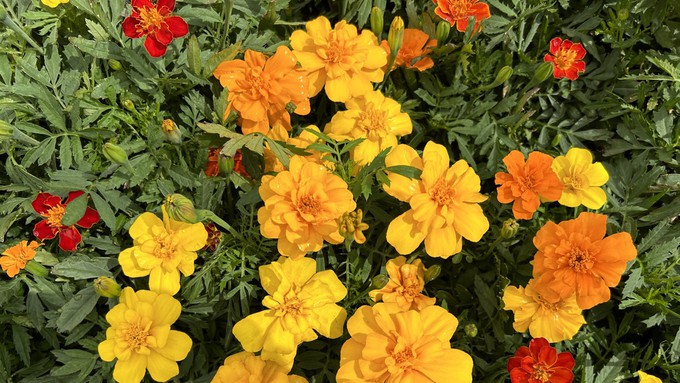
Make most of mild Memorial Day weekend weather

Transplant marigolds now for continued summer color. Some gardeners like to edge their vegetable planting areas with marigolds. Kathy Morrison
Our weird spring weather continues into the unofficial start of summer – but who’s complaining? Milder than normal temperatures give us procrastinating gardeners more time to plant tomatoes and a lot more.
According to the National Weather Service, a marine layer hanging offshore of San Francisco Bay pushed into the Delta. More moisture and turbulent conditions were expected to produce thunderstorms (and hail) in the foothills and Sierra.
While Sacramento may not have many clouds, we get the benefit of that cool moisture surrounding the Valley and lower-than-normal temperatures.
Average high for the last week of May in Sacramento: 85 degrees. Last year, Memorial Day weekend hit 102 degrees.
Instead, Sacramento saw four straight days this past week in the mid to low 70s. After a high of 92 on Monday (May 22), Thursday only reached 72 – a 20-degree drop.
More 70s are forecast for Sacramento by the weather service for Sunday, Monday and Tuesday, before we edge into the low 80s. But we’re expected to remain on the cool side of normal through next weekend.
Make the most of these cooler temperatures. Get to work!
* Keep an eye out for slugs, snails, earwigs and aphids that want to dine on tender new growth.
* Feed summer bloomers with a balanced fertilizer.
* For continued bloom, cut off spent flowers on roses as well as other flowering plants.
* Don’t forget to water. Seedlings need moisture. Deep watering will help build strong roots and healthy plants.
* Put your veggie garden on a regular diet. Set up a monthly fertilizing program, and keep track on your calendar. Make sure to water your garden before applying any fertilizer to prevent “burning” your plants. (Also, don't fertilize droopy or stressed plants -- it will just stress them more.)
* As spring-flowering shrubs finish blooming, give them a little pruning to shape them, removing old and dead wood. Lightly trim azaleas, fuchsias and marguerites for bushier plants.
* Add mulch to the garden to maintain soil moisture and cut down on weeds. Leave about a 6-inch to 1-foot circle around tree or shrub trunks to avoid crown rot or other problems.
* Plant, plant, plant! Set out tomato transplants along with peppers, eggplants, squash and melons.
* Direct-seed melons, cucumbers, summer squash, corn, radishes, pumpkins and annual herbs such as basil.
* In the flower garden, direct-seed or transplant sunflowers, cosmos, salvia, zinnias, marigolds, celosia and asters.
* Plant dahlia tubers. Other perennials to set out include verbena, coreopsis, coneflower and astilbe.
* Transplant summer color such as petunias and marigolds.
Comments
0 comments have been posted.Sacramento Digs Gardening to your inbox.
Sites We Like
Garden Checklist for week of April 14
It's still not warm enough to transplant tomatoes directly in the ground, but we’re getting there.
* April is the last chance to plant citrus trees such as dwarf orange, lemon and kumquat. These trees also look good in landscaping and provide fresh fruit in winter.
* Smell orange blossoms? Feed citrus trees with a low dose of balanced fertilizer (such as 10-10-10) during bloom to help set fruit. Keep an eye out for ants.
* Apply slow-release fertilizer to the lawn.
* Thoroughly clean debris from the bottom of outdoor ponds or fountains.
* Spring brings a flush of rapid growth, and that means your garden needs nutrients. Fertilize shrubs and trees with a slow-release fertilizer. Or mulch with a 1-inch layer of compost.
* Azaleas and camellias looking a little yellow? If leaves are turning yellow between the veins, give them a boost with chelated iron.
* Trim dead flowers but not leaves from spring-flowering bulbs such as daffodils and tulips. Those leaves gather energy to create next year's flowers. Also, give the bulbs a fertilizer boost after bloom.
* Pinch chrysanthemums back to 12 inches for fall flowers. Cut old stems to the ground.
* Mulch around plants to conserve moisture and control weeds.
* From seed, plant beans, beets, cantaloupes, carrots, corn, cucumbers, melons, radishes and squash.
* Plant onion sets.
* In the flower garden, plant seeds for asters, cosmos, celosia, marigolds, salvia, sunflowers and zinnias.
* Transplant petunias, zinnias, geraniums and other summer bloomers.
* Plant perennials and dahlia tubers for summer bloom.
* Mid to late April is about the last chance to plant summer bulbs, such as gladiolus and tuberous begonias.
* Transplant lettuce seedlings. Choose varieties that mature quickly such as loose leaf.